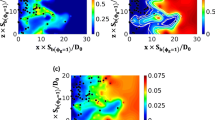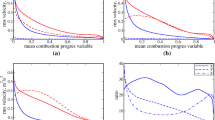Abstract
Statistically planar turbulent premixed and partially premixed flames for different initial turbulence intensities are simulated for global equivalence ratios < ϕ > = 0.7 and < ϕ > = 1.0 using three-dimensional Direct Numerical Simulations (DNS) with simplified chemistry. For the simulations of partially premixed flames, a random distribution of equivalence ratio following a bimodal distribution of equivalence ratio is introduced in the unburned reactants ahead of the flame. The simulation parameters in all of the cases were chosen such that the combustion situation belongs to the thin reaction zones regime. The DNS data has been used to analyse the behaviour of the dissipation rate transports of both active and passive scalars (i.e. the fuel mass fraction Y F and the mixture fraction ξ) in the context of Reynolds Averaged Navier–Stokes (RANS) simulations. The behaviours of the unclosed terms of the Favre averaged scalar dissipation rates of fuel mass fraction and mixture fraction (i.e. \(\widetilde {\varepsilon }_Y =\overline {\rho D\nabla Y_F^{\prime \prime } \cdot \nabla Y_F^{\prime \prime } } /\overline{\rho }\) and \(\widetilde {\varepsilon }_\xi =\overline {\rho D\nabla \xi ^{\prime \prime }\cdot \nabla \xi ^{\prime \prime }} /\overline {\rho })\) transport equations have been analysed in detail. In the case of the \(\widetilde {\varepsilon }_Y \) transport, it has been observed that the turbulent transport term of scalar dissipation rate remains small throughout the flame brush whereas the terms due to density variation, scalar–turbulence interaction, reaction rate and molecular dissipation remain the leading order contributors. The term arising due to density variation remains positive throughout the flame brush and the combined contribution of the reaction and molecular dissipation to the \(\widetilde {\varepsilon }_Y \) transport remains negative throughout the flame brush in all cases. However, the behaviour of scalar–turbulence interaction term of the \(\widetilde {\varepsilon }_Y \) transport equation is significantly affected by the relative strengths of turbulent straining and the straining due to chemical heat release. In the case of the \(\widetilde {\varepsilon }_\xi \) transport, the turbulent transport term remains small throughout the flame brush and the density variation term is found to be negligible in all cases, whilst the reaction rate term is exactly zero. The scalar–turbulence interaction term and molecular dissipation term remain the leading order contributors to the \(\widetilde {\varepsilon }_\xi \) transport throughout the flame brush in all cases that have been analysed in the present study. Performances of existing models for the unclosed terms of the transport equations of \(\widetilde {\varepsilon }_Y \) and \(\widetilde {\varepsilon }_\xi \) are assessed with respect to the corresponding quantities obtained from DNS data. Based on this exercise either suitable models have been identified or new models have been proposed for the accurate closure of the unclosed terms of both \(\widetilde {\varepsilon }_Y \) and \(\widetilde {\varepsilon }_\xi \) transport equations in the context of Reynolds Averaged Navier–Stokes (RANS) simulations.
Similar content being viewed by others
References
Bilger, R.W.: Some aspects of scalar dissipation. Flow Turbul. Combust. 72, 93 (2004)
Borghi, R., Dutoya, D.: On the scales of the fluctuations in turbulent combustion. Proc. Combust. Instit. 17, 235 (1978)
Borghi, R.: Turbulent premixed combustion: further discussions on scales of fluctuations. Combust. Flame 80, 304 (1990)
Mantel, T., Borghi, R.: A new model of premixed wrinkled flame propagation based on a scalar dissipation equation. Combust. Flame 96, 443 (1990)
Mura, A., Borghi, R.: Towards an extended scalar dissipation equation for turbulent premixed combustion. Combust. Flame 133, 193 (2003)
Swaminathan, N., Bray, K.N.C.: Effect of dilatation on scalar dissipation in turbulent premixed flames. Combust. Flame 143, 549 (2005)
Swaminathan, N., Grout, R.: Interaction of turbulence and scalar fields in premixed flames. Phys. Fluids 18, 045102 (2006)
Chakraborty, N., Swaminathan, N.: Influence of the Damköhler number on turbulence–scalar interaction in premixed flames. I. Physical Insight. Phys. Fluids 19, 045103 (2007)
Chakraborty, N., Swaminathan, N.: Influence of the Damköhler number on turbulence–scalar interaction in premixed flames. II. Model development. Phys. Fluids 19, 045104 (2007)
Chakraborty, N., Rogerson, J.W., Swaminathan, N.: A priori assessment of closures for scalar dissipation rate transport in turbulent premixed flames using direct numerical simulation. Phys. Fluids 20, 045106 (2008)
Ribert, G., Champion, M., Gicquel, O., Darabiha, N., Veynante, D.: Modeling nonadiabatic turbulent premixed reactive flows including tabulated chemistry. Combust. Flame 141, 271 (2005)
Robin, V., Mura, A., Champion, M., Plion, P.: A multi-Dirac presumed PDF model for turbulent reacting flows with variable equivalence ratio. Combust. Sci. Technol. 178, 1843 (2006)
Mura, A., Robin, V., Champion, M.: Modeling of scalar dissipation in partially premixed turbulent flames. Combust. Flame 149, 217 (2007)
Bray, K.N.C.: Turbulent reacting flows with premixed reactants. In: Libby, P.A., Williams, F.A. (eds.) Turbulent Reacting Flows, pp. 115–183. Springer, Berlin (1980)
Libby, P.A., Bray, K.N.C.: Implications of the laminar flamelet in premixed turbulent combustion. Combust. Flame 39, 33 (1980)
Boger, M., Veynante, D., Boughanem, H., Trouve, A.: Direct numerical simulation analysis of flame surface density concept for large eddy simulation of turbulent premixed combustion. Proc. Combust. Instit. 27, 917 (1998)
Veynante, D., Vervisch, L.: Turbulent combustion modelling. Prog. Energy Combust. Sci. 28, 193 (2001)
Vervisch, L., Hauguel, R., Domingo, P., Rullaud, P.: Three facets of turbulent combustion modelling: DNS of premixed V-Flame, LES of lifted nonpremixed flame and RANS of jet-flame. J. Turbul. 5, 4 (2004)
Kolla, H., Rogerson, J., Chakraborty, N., Swaminathan, N.: Scalar dissipation rate modelling and its validation. Combust. Sci. Tech. 181, 518 (2009)
Tarrazo, E., Sanchez, A., Linan, A., Williams, F.: A simple one-step chemistry model for partially premixed hydrocarbon combustion. Combust. Flame 147, 32 (2006)
Egolfopoulos, F.N., Cho, P., Law, C.K.: Laminar flame speeds of methane–air mixtures under reduced and elevated pressures. Combust. Flame 76, 375 (1989)
Eswaran, V., Pope, S.B.: Direct numerical simulations of the turbulent mixing of a passive scalar. Phys. Fluids 31, 506 (1988)
Hélie, J., Trouvé, A.: Turbulent flame propagation in partially premixed combustion. Proc. Combust. Inst. 27, 891 (1998)
Malkeson, S., Chakraborty, N.: A-priori direct numerical simulation assessment of algebraic models of variances and dissipation rates in the context of Reynolds averaged Navier Stokes simulations for low Damköhler number partially premixed combustion. Combust. Sci. Technol. (2010). doi:10.1080/00102200903476722
Poinsot, T., Echekki, T., Mungal, M.: A study of the laminar flame tip and implications for turbulent premixed combustion. Combust. Sci. Technol. 81, 45 (1992)
Treurniet, T.C., Nieuwstadt, F.T.M., Boersma, B.J.: Direct numerical simulation of homogeneous turbulence in combination with premixed combustion at low Mach number modeled by the G-equation. J. Fluid Mech. 565, 25 (2006)
Bilger, R.W.: The structure of turbulent non-premixed flames. Proc. Combust. Inst. 23, 475 (1988)
Bray, K.N.C., Domingo, P., Vervisch, L.: Role of the progress variable in models for partially premixed turbulent combustion. Combust. Flame 141, 431 (2005)
Jenkins, K.W., Cant, R.S.: DNS of turbulent flame kernels. In: Proc. of the Second AFOSR Conference on DNS and LES, p. 192. Kluwer Academic, Dordrecht (1999)
Rogallo, R.S.: Numerical experiments in homogeneous turbulence. NASA Technical Memorandum 81315. NASA Ames Research Center, California (1981)
Batchelor, G.K., Townsend, A.A.: Decay of turbulence in the final period. Proc. R. Soc. Lond. A194, 527 (1948)
Trouvé, A., Poinsot, T.J.: The evolution equation for the flame surface density in turbulent premixed combustion. J. Fluid Mech. 278, 1 (1994)
Pantano, C.: Direct simulation of non-premixed flame extinction in a methane–air jet with reduced chemistry. J. Fluid Mech. 514, 231 (2004)
Chakraborty, N., Cant, S.: Unsteady effects of strain rate and curvature on turbulent premixed flames in an inflow–outflow configuration. Combust. Flame 137, 129 (2004)
Grout, R.W.: An age extended progress variable for conditioned reaction rates. Phys. Fluids 19, 105107 (2007)
Peters, N.: Turbulent Combustion. Cambridge University Press, Cambridge (2000)
Poinsot, T., Lele, S.K.: Boundary conditions for direct numerical simulations of compressible viscous flows. J. Comp. Physiol. 101, 104 (1992)
Wray, A.A.: Minimal storage time advancement schemes for spectral methods. NASA Ames Research Center, California, Report No. MS 202 A-1 (1990)
Haworth, D., Blint, R., Cuenot, B., Poinsot, T.: Numerical simulation of turbulent propane–air combustion with nonhomogeneous reactants. Combust. Flame 121, 395 (2000)
Jimenez, C., Cuenot, B., Poinsot, T., Haworth, D.: Numerical simulation and modelling for lean stratified propane–air flames. Combust. Flame 128, 1 (2002)
Echekki, T., Chen, J.H.: Unsteady strain rate and curvature effects in turbulent premixed methane–air flames. Combust. Flame 106, 184 (1996)
Echekki, T., Chen, J.H.: Analysis of the contribution of curvature to premixed flame propagation. Combust. Flame 118, 303 (1999)
Peters, N., Terhoeven, P., Chen, J.H., Echekki, T.: Statistics of flame displacement speeds from computations of 2-D unsteady methane–air flames. Proc. Combust. Instit. 27, 833 (1998)
Hawkes, E.R., Chen, J.H.: Direct numerical simulation of hydrogen enriched lean premixed methane–air flames. Combust. Flame 138, 242 (2004)
Hawkes, E.R., Chen, J.H.: Evaluation of models for flame stretch due to curvature in the thin reaction zones regime. Proc. Combust. Instit. 30, 647 (2005)
Lee, S., Lele, S.K., Moin, P.: Simulation of spatially evolving turbulence and applicability of Taylor’s hypothesis in compressible flow. Phys. Fluids A 4(8), 1521 (1992)
Zhou, J., Nishida K., Yoshikazi, T., Hiroyasu, H.: Flame propagation characteristics in a heterogeneous concentration distribution of a fuel–air mixture. SAE Paper No. 982563 (1998)
Chakraborty, N., Klein, M., Swaminathan, N.: Effects of Lewis number on reactive scalar gradient alignment with local strain rate in turbulent premixed flames. Proc. Combust. Instit. 32, 1409 (2009)
Tennekes, H., Lumley, J.L.: A First Course in Turbulence, 17th edn. MIT, Cambridge (1999)
Batchelor, G.K.: The effect of homogeneous turbulence on material lines and surfaces. Proc. Roy. Soc. Lond. A 231, 349 (1952)
Batchelor, G.K.: Small scale variations of convected quantities like temperature in turbulent fluid, part 1, general discussion and the case of small conductivity. J. Fluid Mech. 5, 113 (1959)
Gibson, C.: Fine structure of scalar fields mixed by turbulence. I. Zero gradient points and minimal gradient surfaces. Phys. Fluids 11, 2305 (1968)
Clay, J.P.: Turbulent mixing of temperature in water, air and mercury. Ph.D. thesis, University of California, San Diego (1973)
Kerr, R.M.: Higher-order derivative conditions and the alignment of small scale structures. J. Fluid Mech. 153, 31 (1985)
Ruetsch, G., Maxey, M.: Small scale features of vorticity and passive scalar fields in homogeneous isotropic turbulence. Phys. Fluids A 3(6), 1587 (1991)
Nomura, K., Elghobashi, S.: Mixing characteristics of an inhomogeneous scalar in isotropic homogeneous sheared turbulence. Phys. Fluids A 4, 606 (1992)
Ashurst, W.T., Peters, N., Smooke, M.D.: Numerical simulation of turbulent flame structure with non-unity Lewis number. Combust. Sci. Technol. 53, 339 (1987)
Leonard, A.D., Hill, J.C.: Scalar dissipation and mixing in turbulent reacting flows. Phys. Fluids A 3(5), 1286 (1991)
Ashurst, W.T., Kerstein, A., Kerr, R., Gibson, C.: Alignment of vorticity and scalar gradient in simulated Navier–Stokes turbulence. Phys. Fluids A 30, 2342 (1987)
Newman, G.R., Launder, B.E., Lumley, J.L.: Modelling the behaviour of homogeneous scalar turbulence. J. Fluid. Mech. 111, 217 (1981)
Jones, W.P., Musonge, P.: Closure of the Reynolds stress and scalar flux equations. Phys. Fluids 31, 3589 (1988)
Veynante, D., Trouve, A., Bray, K.N.C., Mantel, T.: Gradient and counter-gradient transport in turbulent premixed flames. J. Fluid Mech. 332, 263 (1997)
Chakraborty, N., Cant, R.S.: Effects of Lewis number on scalar transport in turbulent premixed flames. Phys. Fluids 21, 035110 (2009)
Domingo, P., Vervisch, L., Bray, K.N.C.: Partially premixed flamelets in LES of non-premixed turbulent combustion. Combust. Theory Model. 6, 529 (2002)
Mura, A., Robin, V., Champion, M., Hasegawa, T.: Small scale features of velocity and scalar fields in turbulent premixed flames. Flow Turbul. Combust. 82, 339 (2009)
Mura, A., Tsuboi, K., Hasegawa, T.: Modelling of the correlation between velocity and reactive scalar gradients in turbulent premixed flames based on DNS data. Combust. Theory Model. 12, 671 (2008)
Chakraborty, N., Swaminathan, N.: Effects of Lewis number on scalar dissipation transport and its modelling in turbulent premixed combustion. Combust. Sci. Technol. (2010). doi:10.1080/00102201003639276
Author information
Authors and Affiliations
Corresponding author
Rights and permissions
About this article
Cite this article
Malkeson, S.P., Chakraborty, N. Statistical Analysis of Scalar Dissipation Rate Transport in Turbulent Partially Premixed Flames: A Direct Numerical Simulation Study. Flow Turbulence Combust 86, 1–44 (2011). https://doi.org/10.1007/s10494-010-9283-2
Received:
Accepted:
Published:
Issue Date:
DOI: https://doi.org/10.1007/s10494-010-9283-2




